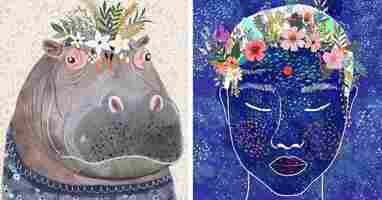Can I teach myself Adobe Illustrator?
9 Easy Ways To Teach Yourself Graphic Design — Jordan Prindle
1 | Research Graphic Design History

The importance of knowing design history is often under-valued.
The value of history, in general, is often under-valued. I know I wasn't exactly thrilled about my history classes back in high school.
But, understanding history, helps you understand why graphic design is used the way it is.
For instance, I bet you didn’t realize that the first designs date all the way back to ~38,000 BCE. Historians believe that the first cave paintings were created to illustrate stories.
Today, our draw towards visual communication only grows. Studies have proven that 65% of people are visual learners, meaning they understand and grasp a concept better when it is visualized in front of them. - Source That is why icons are such powerful communication tools for all types of business owners.
This demand for visual communication dates as far back as human existence, which highlights just how important understanding design history is to understanding designs use and relevance today.
There are a ton of great ways to research design history, but I love graphic design books.
2 | Research Graphic Design Terms
Before you begin learning how to create graphics that convert viewers into loyal readers, you'll need to learn a few basic design terms.
The graphic design world has its own terminology, just like any field of study. Knowing and understanding those terms is a vital first step in teaching yourself design.
Once you begin watching tutorials or reading blogs, a lot of basic design terms will be used that you may not understand, which is going to make it a lot harder to complete the tutorial.
Here are a few basic terms you should know to get you started:
TYPOGRAPHY TERMS
Typography: is the design or selection of letterforms to be organized into words and sentences.
Body Copy: refers to the main group of text in your design.
Leading: is the adjustment between lines of text to improve legibility.
Kerning: is the adjustment between two individual letterforms to improve legibility.
Tracking: is the adjustment between all letterforms in a text to improve legibility.
Legibility: references how easy it is to distinguish between the individual letterforms.
Orphans & Widows: refers to the word(s) that appear at the top or bottom of a column of text. You typically want to avoid orphans and widows in your design.
Alignment: refers to how you organize elements on the page.
Pull Quote: a brief, attention-catching quotation, typically taken from the main text of an article and used as a subheading or graphic feature.
COLOR TERMS
Color Palette: a collection of colors that is used in an illustration, brand or design project.
Hue:a gradation or variety of a color
Tint: is the process of adding white to a color to make the hue brighter.
Shade: is the process of adding black to a color to make the hue darker.
Monochromatic: A color scheme built out of only one color, including tints and shades of that color.
Analogous: A color scheme built out of three colors that are next to each other on the color wheel.
Complementary: A color scheme built out of two colors that sit opposite each other on the color wheel.
Triadic: A color scheme built out of three colors equally spaced around the color wheel.
CMYK: Or Cyan, Magenta, Yellow, and Black, is a color model that is used for print purposes.
RGB: Or Red, Green, and Blue is a color model that is used for on-screen purposes
Pantone (PMS): Pantone Matching System is a standardized system of colors for printing. Every Pantone shade is numbered, making it much easier for people to reference and identify exact shades of color.
PHOTOGRAPHY TERMS
Opacity: The degree of transparency an element has. The lower the opacity, the more transparent an element is.
Resolution: The amount of detail an image has. Generally speaking, the higher your resolution, the better your images appear.
Stock Photo: A professionally shot photograph available online for licensing. Stock photos are usually used when you can’t hire a professional photographer.
Rule of Thirds: The design theory that if you divide your image with two vertical and two horizontal lines, the areas where your lines intersect will become focal points.
These are just a few of the design terms, you may want to know. If you are interested in a more specific type of design, like brand design, web design, or packaging design, you’ll want to research some genre-specific terms.
3 | Utilize Graphic Design Blogs
There are countless graphic design blogs and vlogs that detail the basics and beyond.
Blogs are a great resource for beginners because, not only is the content free. But, credible blogs are kept updated for their readers to teach new trends, software, and techniques.
I think graphic design books are an amazing resource, but blogs are an exceptional resource that can be overlooked.
The issue, is finding credible sources.
Luckily for you, I’ve rounded up a few great resources to help you out.
GRAPHIC DESIGN
BRAND DESIGN
Don't waste these great free resources. You'll learn a lot of the basics in a way that won't feel like school and won’t cost you a penny.
Interview: Self-Taught Illustrator Mia Charro Talks Learning Digital and the Power of Positive Thinking
I find few things as delightful as animals wearing flower crowns. For years, illustrator Mia Charro has imagined what cats, dogs, sloths, and even hippos would look like adorned with colorful blossoms placed atop their heads. I’m not the only person who finds this series endearing—it’s gained a lot of positive attention for her work. (You can find it on Instagram and Society6!)

I spoke to Mia about the ongoing series and the path she took to becoming an illustrator. Spoiler alert: she wasn’t always an illustrator! Learn more about how she shaped her career and how the power of positive thinking is at the heart of much of her imagery.
You’ve said before that you didn’t attend art school, and that you developed your skills as an illustrator and designer at your first job. Can you explain more about this journey?
Of course. Ever since I can remember I’ve always liked to draw. I illustrated my own stories and I filled up the school’s tables with doodles, plants, and robots drawn with a pencil. But I never thought about working with it. After college I decided to take a web design course and, among other programs, I learned how to use Photoshop. I discovered the wonderful world of Control + Z, which allowed you to solve mistakes, use layers and how they fused together… It was new territory that was unwrapping right in front of me. So, I spent lots of time at home experimenting, I even wrote a poetry book with digital collages.
What did you learn for yourself and how did you eventually transition into illustration?
Later on and thanks to this course, I started to work in a company that designed online courses. In order to make these courses, they gave us instructions that were the explanation of the text and the description of an image that had to go with it. We had to look for that image or a similar one in stock sites, which took a very long time, so I concluded that it was much quicker to make a drawing in Adobe Flash. My bosses liked the idea and that’s how I started to create a whole lot of vector illustrations.
Many times, we had some free time at work and I dedicated those hours to draw and learn how to use other programs like Adobe Illustrator; with patience and a lot of practice. The most valuable lesson I learned around that time was that, even though I was a little tired of making stock-like illustrations (people in meetings, shaking hands, walking down the city, talking, at a work table…), they allowed me to develop my technique a lot. So, “you never know when something bad turns into a blessing”.
When I had the idea to write stories, illustrating them came naturally. Writing and illustrating at the same time allows you to dive deeply into the creative process.
What is your process for creating your work digitally?
The idea comes first, like a flash, something you want to draw and communicate. I honestly do sketches on paper very rarely. I tend to work directly on the computer, and I fix shapes and change colors during the process. Truth is I save a lot on paper and materials